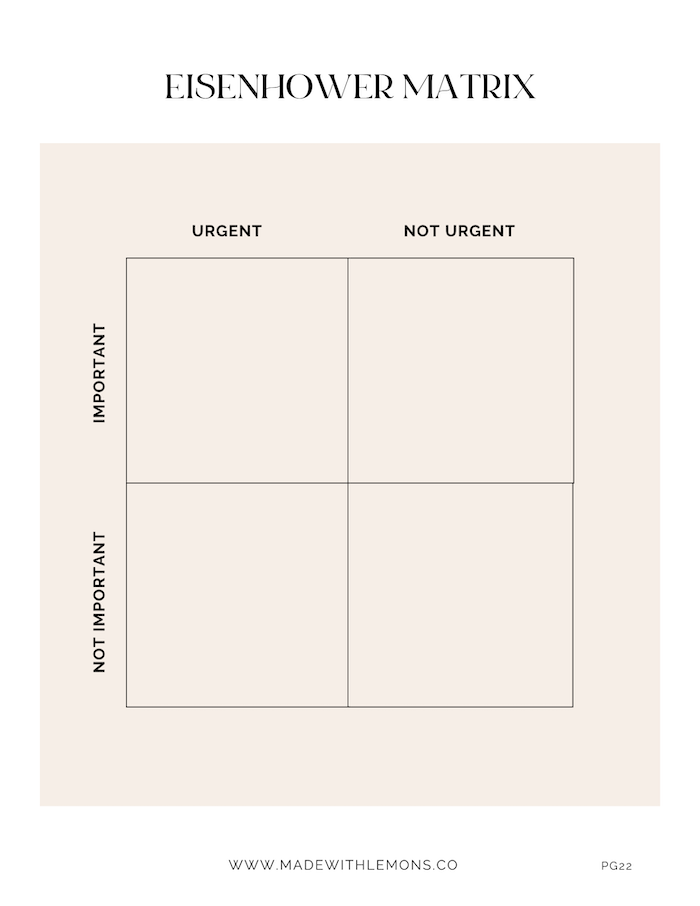
As a species, we’re more productive than we’ve ever been, yet we also work longer hours than ever before. That just doesn’t add up. But our work culture has us convinced that our lives should revolve around our work, not the other way around. This kind of toxic “hustle culture” can lead to burnout, overwhelm, and even depression. If you’re someone who works too much (and lives too little), check out my work life balance tips and mindset shifts.
How to Know If You’re Working Too Much
I spent years working too much without realizing it. Had I taken the time to look around, I would have seen the signs: I was exhausted all the time, constantly sick, and quick to break down about the tiniest things. Unfortunately, it took hitting rock bottom for me to recognize that I was overworking myself.
Whether you’re feeling great at work or you’re totally unfulfilled, take a moment to look for the signs of overworking:
- You’re tired most of the time or you struggle to fall and stay asleep at night.
- You experience mood swings, especially at work or when confronted with non-work tasks or chores.
- You’ve lost contact with friends and family, and you can’t find the time or energy to reconnect with them.
- You’re often sick with small illnesses like colds and flus.
- You no longer pursue hobbies or activities outside of work.
- You struggle to concentrate, even on tasks that you usually enjoy.
If you’re experiencing any of these feelings, there’s a really good chance your work life balance is out of whack. Here’s how to get it back on track.
6 Work Life Balance Tips & Mindset Shifts for People Who Work Too Much
1. Set official office hours.
I know it seems like a simple thing, but it’s honestly my best work life balance tip (and the one I suggest to my coaching clients first). Decide how many hours you want to work each day, and then create a schedule. Write it down, include it in your contracts, and communicate it with your clients and team.
Of course, setting a schedule is a lot easier than keeping a schedule. When you first get started, create alarms to remind you when to ‘clock in’ and ‘clock out’. Create a wind-down routine that helps you relax and get out of the work mindset at the end of the day.
As you’re scheduling your tasks, consult your calendar to ensure you have enough time to complete each day’s to-do list. When you assign yourself too many tasks each day, you set yourself up for a long night. Keep your tasks to a minimum to prevent that.
Most importantly, be intentional with your time when you are working. The less distracted you get, the less ‘overtime’ you’ll have to work in the evenings and on weekends.
Like this post?
Sign up for our weekly newsletter and we’ll send you more awesome posts like this!
2. Schedule regular check-ins.
It’s easy to get so distracted by day-to-day tasks that you completely lose sight of your goals. Before you know it, you’re working 12-hour days and running yourself into the ground for someone else’s dream instead of your own.
To stay on track, schedule regular check-ins with yourself. Once a month, sit down with a journal and ask yourself…
- What do I want my life to look like in a year?
- What do I want my life to look like in five years?
- Which of my daily tasks get me closer to my goals?
- What parts of my current workload don’t serve these goals?
- Am I fulfilled in my day-to-day life?
Your answers to these questions can be very telling. They’ll show you if you’re moving in the right direction or if you’ve lost sight of your goals altogether. If you find that your day-to-day life is unaligned with your long-term goals, make adjustments. Shift your energy to the work that gets you closer to your vision of the future, and delegate, automate, or eliminate the work that doesn’t. Make time to pursue your non-work interests and hobbies. When you start taking baby steps towards the life you want, you’ll learn to recognize tasks and responsibilities that don’t serve you.
3. Treat yourself like your own employee.
You are your business’s top employee. So treat yourself like it! Take some time to consider how you would treat your top employee if you owned a major corporation. For example, you might…
- Encourage them to take sick days and mental health days when they needed them
- Allow them flexibility to complete their work on the schedule that works best for them
- Provide them ample time and resources to pursue their education and other interests
- Check in regularly to make sure they’re feeling appreciated at work
- Insist that they take regular breaks and utilize their hard-earned vacation time
Now ask yourself, “Do I treat myself as well as I’d treat my top employee?” If not, it’s time to make some adjustments. A good boss recognizes that their employees do their best work when they’re fulfilled, well-rested, and fairly compensated. Give yourself the same level of respect and grace. Take time off. Pursue non-work interests. And most importantly, recognize that investing in your work life balance means investing in your business.
4. Use the Eisenhower Matrix for task management.
Does your to-do list just keep getting longer? Chances are, you could delegate, reschedule, or eliminate several of those tasks! If you’re not sure where to start, use the Eisenhower Matrix. Look at each task, and ask yourself if it is 1) urgent and 2) important.
If a task is important and urgent, do it. This is a task that needs to be completed soon and requires your personal attention.
If a task is important but not urgent, reschedule it. There’s no shame in pushing back a task that doesn’t have to get done today.
If a task is urgent but not important, delegate it. Outsource, outsource outsource! Your team can get this task done in a timely manner without your personal involvement.
If a task is neither urgent nor important, delete it. This task isn’t serving you or your business. You don’t need it!
This simple exercise can cut your to-do list in half and totally shift your mindset around work. Try it for a week, and see how it feels!

5. Break up with your phone.
How many times have you answered a work email from bed in the morning or while you’re waiting for the waiter at a restaurant? It might seem small, but even a task as small as checking your email can take you out of your ‘life’ mindset and back into your ‘work’ mindset.
The easiest way to create distance between your home and work is disconnecting from your devices. Set aside a couple hours each day to spend entirely away from your screens. If that seems drastic, just try starting and ending your day with a few screen-free moments. Even a little time away from your emails and apps can help calm your mind and create distance between you and work.
Work Life Balance Books
Do Nothing: How to Break Away from Overworking, Overdoing, and Underliving by Celeste Headlee. Do you feel guilty when you’re “unproductive?” If so, you need to read this book. It’ll have you questioning everything you know about hustle culture.
Burnout: The Secret to Unlocking the Stress Cycle by Emily Nagoski & Amelia Nagosk. Businesswomen, this one’s for you! This book explains why women experience burnout differently than men and what we can do about it. Whether you’re an entrepreneur or traditionally employed, it’s a must-read.
Set Boundaries, Find Peace: A Guide to Reclaiming Yourself by Nedra Glover Tawwab. Boundaries are hard to set and even harder to keep, especially when they’re boundaries you set with yourself. This book provides practical steps for setting those boundaries and reclaiming your time.
Want to create a better work life balance and free up time for the things you love?
When you live and work with intention, you’re more fulfilled, less overwhelmed, and more in love with everyday life. Click here to sign up for my FREE webinar on avoiding burnout and creating more intentionality in your life and business.






+ show Comments
- Hide Comments
add a comment